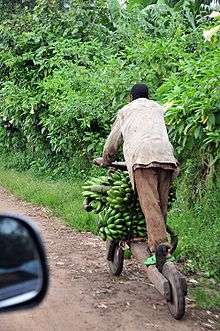Chukudu
The chukudu (or chikudu, cbokoudou, tshukudu)[1] is a two-wheeled handmade vehicle used in the east of the Democratic Republic of Congo. It is made of wood, and is used for transporting cargo.
.jpg)


The chukudu generally has an angular frame, two small wheels (often of wood, sometimes wrapped with rubber), handlebars, and a pad for the operator to place their knee on while propelling the vehicle with their leg.[2] On a descent, the rider stands on the deck like a kick scooter. On flat ground, the rider can put one knee on the deck and push the ground by the other foot like a knee scooter.
Rubber mud flaps and shock absorber springs may be added.[3][4]
History
Chukudus first appeared in the 1970s in North Kivu, during the difficult economic times under Mobutu Sese Seko.[3][5][6]
In 2008, chikudus were selling for US$100 with a cost of materials of nearly US$60.[7] Similarly, in 2014 they cost $50 to $100 and were used to earn up to $10 per day, in an area where most people live on less than $2 per day.[1] A 2014 article estimated a cost of about US$150, which a driver could pay off in about six months, earning $10-$20 per day.[8]
Construction
In Goma, where chukudus form the "backbone of the local transportation system", chukudus are made of hard mumba wood and eucalyptus wood, with scrap tires for wheel treads.[9][10] These chukudus take one to three days to build, and last two to three years. The most commonly used size is about six and one half feet long, and carries a load of 1000 lbs. However, "the largest chukudus can carry up to 800 kilograms of weight."[9]
A small chukudu can be built in about three hours, using dimensional lumber and materials available in a hardware store.[11]
The chukudu is customizable to carry different types of cargo. To haul firewood some chukudus have a hole drilled in the middle of the sitting deck and insert a stick to hold firewood in place. Others have a large basket to carry various loads.[12]
References
- "Tshukudu, the All-Purpose Transport Scooter is Congo's Lifeline". NDTV. July 3, 2014. Retrieved 2015-11-21.
- Robyn Dixon (January 21, 2013). "Congo's chairmen of the boards". Los Angeles Times. Retrieved 2015-11-21.
- Chukudus – A no nonsense local transporter that changes lives of Congo’s poor « TransportGooru
- Moore, Jina. "Scooter Country". Makeshift. Archived from the original on 2019-11-01. Retrieved 2019-02-20.
- Husarska, Anna (March 29, 2009). "The Chukudu Is a Small Ride That's a Big Wheel in Congo". Washington Post.
- McCrummen, Stephanie (February 11, 2010). "In eastern Congo, handmade chukudu scooters rule the road". Washington Post.
- Alex Halperin and Jina Moore (August 29, 2008). "Wood, wheels, workhorse: the chikudu story". Christian Science Monitor. Retrieved 2015-11-21.
- Dijkstra, Andrea (2014-10-02). "Les chukudus, force motrice du commerce à Goma". BlueBiz (in French). Retrieved 2019-02-20.
- Khumo Sebambo (2015-09-22). "This Congolese wooden bicycle-cum-scooter carries hundreds of kilograms". Design Indaba. Retrieved 2019-02-20.
- Ley Uwera (2016-09-18). "Handmade Wooden Vehicle, the Pride of DRC, Keeps Country Running". Global Press Journal. Retrieved 2019-02-20.
- Bradbury, Doug (July 28, 2015). "Build a Wooden Scooter That Can Haul Hundreds of Pounds". Make: DIY Projects and Ideas for Makers. Retrieved 2019-02-20.
- Sebambo, Kuhmo (September 22, 2015). "This Congolese wooden bicycle-cum-scooter carries hundreds of kilograms". designindaba.com. Retrieved 19 August 2019.
See also
External links
| Wikimedia Commons has media related to Tshukudu. |
- Chukudus in Goma - YouTube
- Short video from the BBC
- Chukudus of Goma
- "Build a Wooden Scooter That Can Haul Hundreds of Pounds". Make: DIY Projects and Ideas for Makers. 2015. Retrieved 2019-02-20.